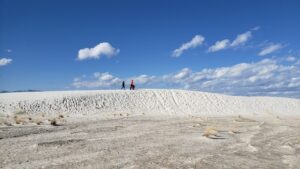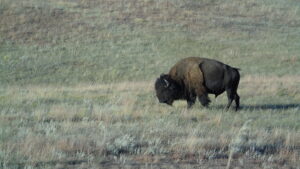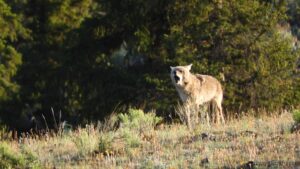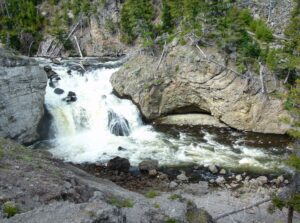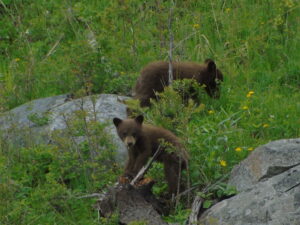 In 2015 we decided our travel experiences were going to be focused on Yellowstone National Park. Specifically, we made it our goal to visit Yellowstone in all four seasons within the year. We accomplished this goal, made it there five separate times between May to December, and learned so much about the park, the wildlife that lives there, and what is worth stopping for as you travel through.
In 2015 we decided our travel experiences were going to be focused on Yellowstone National Park. Specifically, we made it our goal to visit Yellowstone in all four seasons within the year. We accomplished this goal, made it there five separate times between May to December, and learned so much about the park, the wildlife that lives there, and what is worth stopping for as you travel through.

Yellowstone is an enormous park, at around 2.2 million acres (larger than Delaware and Rhode Island combined!), and there are 466 miles of roads that wind through it. With the highest concentration of geothermal features in the world, how does one decide where to spend fleeting vacation time while visiting? If you are limited to less than a week to spend in Yellowstone, we’d like to offer this list of our Top Five Family Stops in Yellowstone:
Lamar Valley – Care to hear the howling of wolves? Or maybe bugling elk are more your interest? Lamar Valley, located in the Northeast corner of the park is home to the bulk of the Yellowstone wolves, as well as elk, bison, coyotes, and more. The best time to stop at this destination is early morning or late afternoon into evening, as the wildlife is much more active during that time. Be sure to stop at the turnout above Round Prairie – the turnout just east of Soda Butte – for the best chance of spotting or hearing the wolves. Soda Butte Creek and Lamar River wind through this area of the park, which is a very big draw for wildlife, especially in the winter months.

We tend to spend almost all of our time in this area, and our kids love trying to spot bison, elk, and even moose. Bald eagles are common here, too. Be sure to pick up a kids’ wildlife scavenger hunt flyer from the park rangers before heading to the Lamar area – the kids will be able to cross off most of the animals on the list in one day!
Lower Falls of the Yellowstone – At this point in the park, the Yellowstone River falls 308 feet (94m), creating one of the largest of about 280 waterfalls in Yellowstone.
The power and force that the falls create is awesome, and kids seem to be fascinated with the falling water. There are several hikes to be taken around these falls, and none of them disappoint. For a nice hike and to see the falls from many angles, allow at least half of a day in this area of the park (Canyon). The view seen above is accessible, but most of the trails include stairs and switchbacks. We did NOT take our special-needs 4-year-old down to see the falls closer, but a child in a backpack would probably be fine.
 Yellowstone Lake/Fishing Bridge – The Lake area is unique from other parts of the park, as it is the oldest inhabited area in the park. The Lake Yellowstone Hotel is a great piece of history and just recently went through a face-lift and the dining room serves local, sustainable food choices. In addition, the lake itself is deep and home to a wide variety of water fowl, including white pelicans. When you stand on the shore of this largest high-elevation lake in the USA, you really feel the impact of the volcano that once raged beneath the area. While you are stopped to check out the lake, be sure to take a stroll across the Fishing Bridge, a historic spot that no longer represents its namesake. Although you can still see plenty of fish from the bridge, at one time it was such a popular fishing location for cutthroat trout, that they were almost wiped out of the river.There are guided ranger walks here, and grizzly bears can be spotted along the river from this bridge, at a safer distance than might occur when hiking on the nearby trails. As a survivalist and a parent, I’m all about wildlife, but safety of my family must come first. Side note: The best in-park food we ate was served at the soda fountain inside the Fishing Bridge Gift Shop area. We ate there three times on two trips!
Yellowstone Lake/Fishing Bridge – The Lake area is unique from other parts of the park, as it is the oldest inhabited area in the park. The Lake Yellowstone Hotel is a great piece of history and just recently went through a face-lift and the dining room serves local, sustainable food choices. In addition, the lake itself is deep and home to a wide variety of water fowl, including white pelicans. When you stand on the shore of this largest high-elevation lake in the USA, you really feel the impact of the volcano that once raged beneath the area. While you are stopped to check out the lake, be sure to take a stroll across the Fishing Bridge, a historic spot that no longer represents its namesake. Although you can still see plenty of fish from the bridge, at one time it was such a popular fishing location for cutthroat trout, that they were almost wiped out of the river.There are guided ranger walks here, and grizzly bears can be spotted along the river from this bridge, at a safer distance than might occur when hiking on the nearby trails. As a survivalist and a parent, I’m all about wildlife, but safety of my family must come first. Side note: The best in-park food we ate was served at the soda fountain inside the Fishing Bridge Gift Shop area. We ate there three times on two trips!
 Old Faithful & Upper Geyser Basin – There is no way you can justify visiting Yellowstone without a stop at Old Faithful Geyser. Although not the tallest erupting geyser in the park, it is the most regular, with projected eruption times even being broadcast by the park on Twitter during the summer season. About every 90 minutes you can watch the spectacle from a bench surrounding the geyser, or for a more aerial view, follow the trail up Geyser Hill to watch the eruption from above. Either way is a treat! Awesomeness tip: many people do not know about the Visitor Education Center located near the geyser. There is so much to see and do inside the center, be sure to stop in, especially while you wait for Old Faithful to erupt!
Old Faithful & Upper Geyser Basin – There is no way you can justify visiting Yellowstone without a stop at Old Faithful Geyser. Although not the tallest erupting geyser in the park, it is the most regular, with projected eruption times even being broadcast by the park on Twitter during the summer season. About every 90 minutes you can watch the spectacle from a bench surrounding the geyser, or for a more aerial view, follow the trail up Geyser Hill to watch the eruption from above. Either way is a treat! Awesomeness tip: many people do not know about the Visitor Education Center located near the geyser. There is so much to see and do inside the center, be sure to stop in, especially while you wait for Old Faithful to erupt!
Mammoth Hot Springs & Terraces – Although this was not my personal favorite spot in the summer time, the town of Mammoth Hot Springs and the accompanying mineral-laden Terraces area are the only true geothermal area located outside of the volcano caldera. The Terraces are a great place for families to learn about geology, minerals, and how water can change the landscape. These terraces are changing all the time, so no return visit is ever the same. If you are visiting in the winter, this location tops the list with the additional steam generated by the cold weather.
The town itself is slowly being renovated, and the Visitor Center here was our favorite in the whole park. On two visits both of our sons requested that this center be our first stop of the day! One final “can’t-miss” location near Mammoth Hot Springs is the trail to the Boiling River. Although it is actually in the Yellowstone River, this popular soaking spot is open year-round, and even in -5 degree F temps can still be a lot of fun. The hot springs that bubble up at this point in the river can actually be TOO hot, so be sure to heed the signage as to where NOT to swim here. Please use life jackets on the kids – depending on the season, the current in this area can be very strong.
Got more than 5 days to spend? We recommend adding on:
- Midway and Lower Geyser Basins, especially world-famous Grand Prismatic Spring, the largest hot spring in the park. The colors around the spring are ethereal and changing all the time.

- Take the scenic drive (or ski route) back to Virginia Cascades, a 60-foot cascading waterfall along the Gibbon Rivera at the edge of the caldera.
- Check out the colorful, acidic Norris Geyser Basin (warning – kids will complain about the smell! It smells strongly of sulfur!)

- Stop at a turnout along Hayden Valley, between Canyon and Lake areas. There are wolves, elk, bears, and more often sighted here.

- Ask around about the many, many ranger-led programs. Most of the areas in our Top 5 above have rangers frequently giving informational talks about it, some unplanned (wildlife spotting), some offered consistently (Old Faithful Geyser). Check on the NPS.gov website for their latest ranger program offerings: http://www.nps.gov/yell/planyourvisit/rangerprog.htm.
